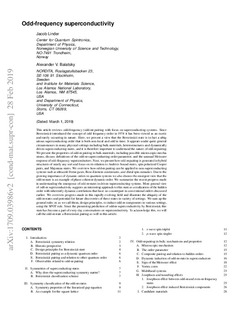| dc.description.abstract | This article reviews odd-frequency (odd-ω) pairing with focus on superconducting systems. Since Berezinskii introduced the concept of odd frequency order in 1974 it has been viewed as an exotic and rarely occurring in nature. Here, we present a view that the Berezinskii state is in fact a ubiquitous superconducting order that is both non-local and odd in time. It appears under quite general circumstances in many physical settings including bulk materials, heterostructures and dynamically driven superconducting states, and it is therefore important to understand the nature of odd-ω pairing. We present the properties of odd-ω pairing in bulk materials, including possible microscopic mechanisms, discuss definitions of the odd-ω superconducting order parameter, and the unusual Meissner response of odd-frequency superconductors. Next, we present how odd-ω pairing is generated in hybrid structures of nearly any sort and focus on its relation to Andreev bound states, spin polarized Cooper pairs, and Majorana states. We overview how odd-ω pairing can be applied to non-superconducting systems such as ultracold Fermi gases, Bose-Einstein condensates, and chiral spin-nematics. Due to the growing importance of dynamic orders in quantum systems we also discuss the emergent view that the odd-ω state is an example of phase coherent dynamic order. We summarize the recent progress made in understanding the emergence of odd-ω states in driven superconducting systems. More general view of odd-ω superconductivity suggests an interesting approach to this state as a realization of the hidden order with inherently dynamic correlations that have no counterpart in conventional orders discussed earlier. We overview progress made in this rapidly evolving field and illustrate the ubiquity of the odd-ω states and potential for future discoveries of these states in variety of settings. We sum up the general rules or, as we call them, design principles, to induce odd-ω components in various settings, using the SPOT rule. Since the pioneering prediction of odd-ω superconductivity by Berezinskii, this state has become a part of every-day conversations on superconductivity. To acknowledge this, we will call the odd-ω state a Berezinskii pairing as well in this article. | nb_NO |
